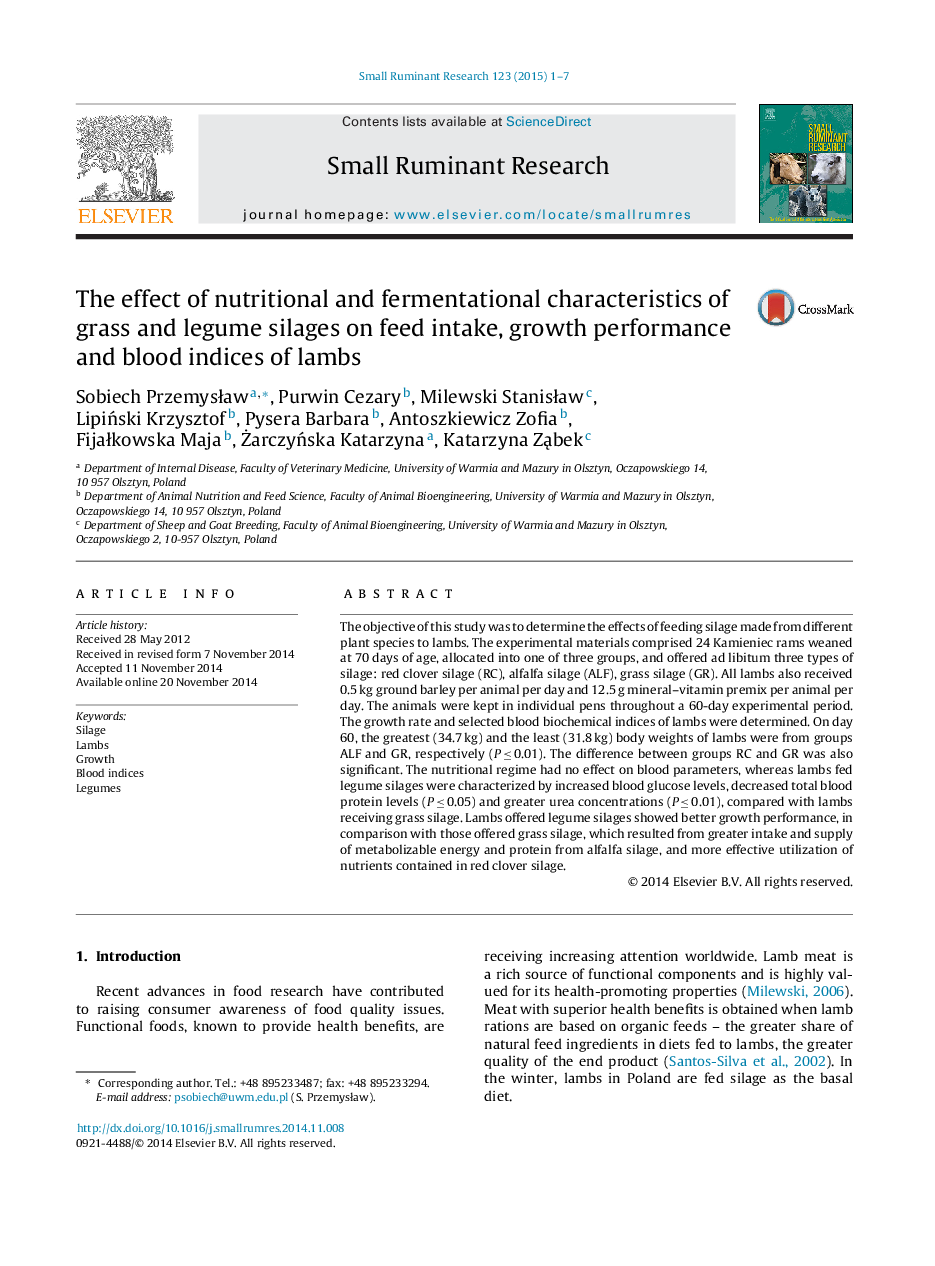| کد مقاله | کد نشریه | سال انتشار | مقاله انگلیسی | نسخه تمام متن |
|---|---|---|---|---|
| 2456931 | 1110661 | 2015 | 7 صفحه PDF | دانلود رایگان |
• On day 60, the greatest (34.7 kg) and the least (31.8 kg) body weights of lambs were from groups ALF and GR, respectively (P ≤ 0.01). The difference between groups RC and GR was also significant (P ≤ 0.05). The nutritional regime had no effect on blood parameters, whereas lambs fed legume silages were characterized by increased blood glucose levels, decreased total blood protein levels (P ≤ 0.05) and significantly greater urea concentrations (P ≤ 0.01), compared with lambs receiving grass silage.
• The average initial body weights of lambs were comparable in all groups, while differences in body weight were observed on experimental day 30 – the body weights of lambs fed red clover silage and alfalfa silage were greater than the body weights of lambs fed grass silage (P ≤ 0.01), which resulted from significantly greater daily gains in groups RC and ALF (P ≤ 0.01).
• On day 60, the final body weights of lambs were greatest in group ALF (34.7 kg), and the difference relative to group GR (31.8 kg) was highly significant.
• Significant (P ≤ 0.05) differences were noted only with regard to two parameters of acid–base balance (Table 4), pO2 and O2 SAT, which decreased toward the end of the experiment.
• The greatest and least glucose concentrations were noted in animals fed alfalfa silage and grass silage, respectively. The noted difference was significant (P ≤ 0.05). Significant (P ≤ 0.05) differences were also found in total serum protein concentrations, which were greatest in lambs fed grass silage and least in lambs fed red clover silage.
• CK activity was comparable in all dietary treatments, but it was found to increase significantly during the study (P ≤ 0.05).
The objective of this study was to determine the effects of feeding silage made from different plant species to lambs. The experimental materials comprised 24 Kamieniec rams weaned at 70 days of age, allocated into one of three groups, and offered ad libitum three types of silage: red clover silage (RC), alfalfa silage (ALF), grass silage (GR). All lambs also received 0.5 kg ground barley per animal per day and 12.5 g mineral–vitamin premix per animal per day. The animals were kept in individual pens throughout a 60-day experimental period. The growth rate and selected blood biochemical indices of lambs were determined. On day 60, the greatest (34.7 kg) and the least (31.8 kg) body weights of lambs were from groups ALF and GR, respectively (P ≤ 0.01). The difference between groups RC and GR was also significant. The nutritional regime had no effect on blood parameters, whereas lambs fed legume silages were characterized by increased blood glucose levels, decreased total blood protein levels (P ≤ 0.05) and greater urea concentrations (P ≤ 0.01), compared with lambs receiving grass silage. Lambs offered legume silages showed better growth performance, in comparison with those offered grass silage, which resulted from greater intake and supply of metabolizable energy and protein from alfalfa silage, and more effective utilization of nutrients contained in red clover silage.
Journal: Small Ruminant Research - Volume 123, Issue 1, January 2015, Pages 1–7
